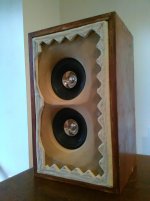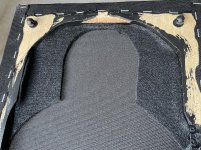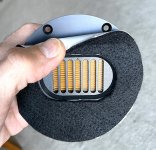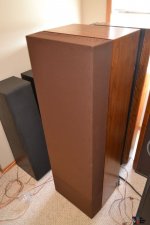Looking for ideas for a frame for grill cloth that is not too terrible in refraction. Old school frames were terrible, which led us to the generations of exposed drivers. My next build I need to protect them. At least the woofer as it will be next to a passage and right at elbow level. Being the woofer. A bit of welded wire hardware cloth may be OK. Ideas?
why not a frame made of a 4 thin solid rods with just 4 very little angles made from cork or solid foam in which the rods are glued or screwed. When the frame is ready just put acoustic grill cloth around the rods then sewn around the metal rod. If the rod is a little thicker then you can use wood... easier for the grill cloth with staples on the rear side of the rod.
Yeah, acoustically small enough features give no reflections. I'm not sure what is actually small enough but the good old 1/4wl at 20kHz is roughly 4mm. If you make a frame and use fabric to cover go no thicker and use round stock. Although, most speakers beam such high frequencies so as long as you are not framing directly in front of the tweeter there shouldn't be problems using a bit thicker stuff.
If you want more protection and use actual grill, I'd say doesn't matter much but never checked out any tests what the influence is. Use grill with big holes and thin "wires" to be sure, bare minimum for protection would be best for audio quality, you are trying to find a balance between the two.
If you want more protection and use actual grill, I'd say doesn't matter much but never checked out any tests what the influence is. Use grill with big holes and thin "wires" to be sure, bare minimum for protection would be best for audio quality, you are trying to find a balance between the two.
Last edited:
Surprisingly small disturbances do have an effect. You can measure the effect of screw heads and even the groove between the recess and a tweeter frame. But for a HT speaker, you are probably right it does not really mater.
I have a suggestion, which should cost nothing to try.
Get a piece of thin card at least as big as the baffle. Cut it to the size of the baffle, and then cut out the middle to leave a 1" wide or bigger "frame".
Mount the card about 3/4" away from the baffle with small bits of 3/4" mdf or whatever.
Do one speaker and leave the other without.
Compare the sounds.
If you decide the one with the frame sounds no worse then you could make the frame out of thin ply, or mdf.
Mounting a grill on it would be pretty simple, and you could use double sided sticky tape to mount it which would prevent damaging the speaker.
(Personally I think it sounds better subjectively; but as long as it sounds no worse to you it would be worth considering)
Get a piece of thin card at least as big as the baffle. Cut it to the size of the baffle, and then cut out the middle to leave a 1" wide or bigger "frame".
Mount the card about 3/4" away from the baffle with small bits of 3/4" mdf or whatever.
Do one speaker and leave the other without.
Compare the sounds.
If you decide the one with the frame sounds no worse then you could make the frame out of thin ply, or mdf.
Mounting a grill on it would be pretty simple, and you could use double sided sticky tape to mount it which would prevent damaging the speaker.
(Personally I think it sounds better subjectively; but as long as it sounds no worse to you it would be worth considering)
Sonus Faber uses elastic fabric rods instead classic fabric cloth. They tense it vertically between the top and the bottom of the front baffle ! Seems good enough for their 120 000 euros loudspeaker.😀 The "speaker grill" word take all its sense : SoundStage! Expert: Sonus faber Olympica Nova Speakers - 2) Grille Care (February 2020) - YouTube.
I personnaly prefer the thin discrete front bafle à la Harbeth where the frame is pushed inside the front bafle so diseaper acoustically as well as visualy 😎
#Harbeth speakers how to remove the grill with bare hands - YouTube
I personnaly prefer the thin discrete front bafle à la Harbeth where the frame is pushed inside the front bafle so diseaper acoustically as well as visualy 😎
#Harbeth speakers how to remove the grill with bare hands - YouTube
Once a speaker costs a few grand, what they do I believe has far mor to do with being different than better.
Go give a listen to a 2Ce again and ask yourself, what could you do better? Is th ebig ML for 100K really that expensive to make compare to an ESL-9? Is a WAMM that great? Sure looks like it violates Olson's best advice. Is the margin for a Moon Opulence greater than Theil CS1.7? I bet it is.
My point is, over about 5 or 6 grand a pair, you are not necessarily buying more accurate sound, but an object of art or bragging. Some exceptions, but not many. So what is done on a million dollar speaker is not a good reference to $500 worth of parts for a HT speaker.
Go give a listen to a 2Ce again and ask yourself, what could you do better? Is th ebig ML for 100K really that expensive to make compare to an ESL-9? Is a WAMM that great? Sure looks like it violates Olson's best advice. Is the margin for a Moon Opulence greater than Theil CS1.7? I bet it is.
My point is, over about 5 or 6 grand a pair, you are not necessarily buying more accurate sound, but an object of art or bragging. Some exceptions, but not many. So what is done on a million dollar speaker is not a good reference to $500 worth of parts for a HT speaker.
View attachment 998361
Here's a mad idea, stick 1/4 inch thick felt to the baffle as a stand off, then wrap in grill cloth, glue around the back of the front baffle, and attach the front baffle to the rest of the cabinet with tension springs ( against a soft vibration absorbing gasket ).
Actually looking at some 1/2" wool felt for a similar idea.
View attachment 998361
Here's a mad idea, stick 1/4 inch thick felt to the baffle as a stand off, then wrap in grill cloth, glue around the back of the front baffle, and attach the front baffle to the rest of the cabinet with tension springs ( against a soft vibration absorbing gasket ).
I have done exactly as you show, except instead of using 1/4" felt I used 1/8" adhesive-backed material to cover the outside of the frame. Mine is black and when covered with grille fabric it is invisible. I have also used it two-sided (adhesive-to-adhesive) to extend over the baffle to the edges of the drivers as a way to minimize baffle step. It definitely helps manage those annoying higher-frequency diffraction effects, especially around the tweeter. I wish I had made before/after measurements, but everybody's "mileage will vary" anyway...
This is the material I have used: Dampers: FELT 1/8" thick x 32" wide, by running foot
This stuff is my secret weapon for bad baffle design! 🙂 The adhesive is strong, so for testing I suggest just exposing small areas of adhesive to help with removal and adjustment.
BTW, I love that scalloped inside edge of your grille frame!
Cheers,
Frank
Attachments
I should add that the 1/8" adhesive-backed felt is also very useful *inside* speaker cabinets. On mid-ranges it is the perfect material for quieting reflections from the front face of basket arms and magnet assemblies. I have also used it in powered monitors to help 'hide' some of the internal electronic components. All to good effect - each being subtle, of course, but the sum of the tweaks is often not subtle. As always, YMMV.
Also, the above grille treatment may not have as much influence in other systems as in mine because these small boxes are almost touching a large video monitor that is highly reflective. When I use the system for critical music listening, I (literally) have a heavy blanket that I drape over the entire monitor screen! 😀
Also, the above grille treatment may not have as much influence in other systems as in mine because these small boxes are almost touching a large video monitor that is highly reflective. When I use the system for critical music listening, I (literally) have a heavy blanket that I drape over the entire monitor screen! 😀
Last edited:
I have been thinking about making a 20mm frame with a bevel on the inside from 6mm mdf with magnets flush mounted and acoustically 'transparent' foam mounted straight to that. Trim to the edge of the frame.
About 30 years ago I had a pair of Acoustic Research bookshelfs that had recessed drivers. There was a small groove 15mm back from the baffle on the top, bottom and sides. The grill had a bit of elastic sewn into it that fitted into the groove to hold on.
I've kept that idea for when I make my next speakers that need grills. Rather than recessing the drivers I would use thick felt and try and get a decent radius on the edges. Maybe use a 1/4 round moulding with the felt pushed up flush to it.
I can't find a pic of the speakers I had, but this pic is visually close.
Rob.
I've kept that idea for when I make my next speakers that need grills. Rather than recessing the drivers I would use thick felt and try and get a decent radius on the edges. Maybe use a 1/4 round moulding with the felt pushed up flush to it.
I can't find a pic of the speakers I had, but this pic is visually close.
Rob.
Attachments
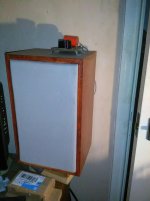
Here is a picture of the speaker with the ( grey ) grill cloth on, the white felt is invisible, I'm not sure this would be true for all grill clothes. The contour network is on the top, I haven't got round to sticking them inside yet. The felt was cut with a bevel.
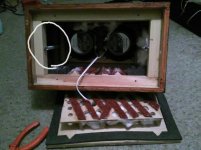
This is the speaker with the back removed, I have put a circle around one of ( the two ) tension springs that hold the front baffle on.
The least obtrusive grill I've seen was first featured in a Linn speaker from the 80s, dubbed Nexus L250. Drivers were mounted flush with the baffle. There was a groove all around the perimeter of the baffle about a cm deep, maybe 2cm from the front. A stretchy cloth with an elastic around its edge, sort of like a shower cap, fitted around the baffle & the elastic was fitted into the groove. No frame of any kind to cause diffraction, only the thin stocking-like cloth. Significantly, the surround of the bass driver was inverted -- likely so it would not make contact with the grill cloth.
I'm building a speaker enclosure integrating this grill system. Am considering mounting the drivers in recesses deep enough to keep the surrounds from touching the grill cloth at high excursion. Will need help from my expert sewing honey. Will post here the results when it finally gets done -- it's been a slow, long haul.


I'm building a speaker enclosure integrating this grill system. Am considering mounting the drivers in recesses deep enough to keep the surrounds from touching the grill cloth at high excursion. Will need help from my expert sewing honey. Will post here the results when it finally gets done -- it's been a slow, long haul.

- Home
- Loudspeakers
- Multi-Way
- Ideas for non-refractive edge grill cloth frame
